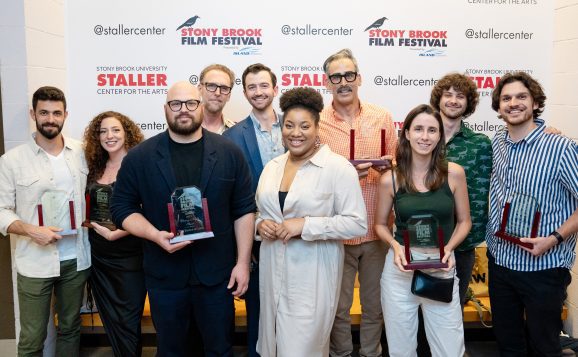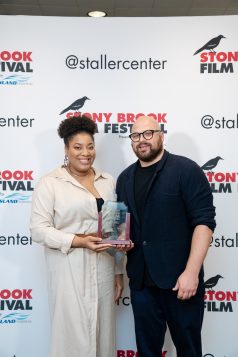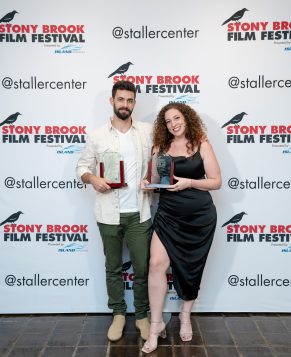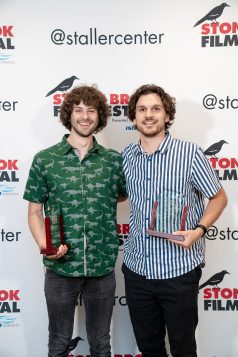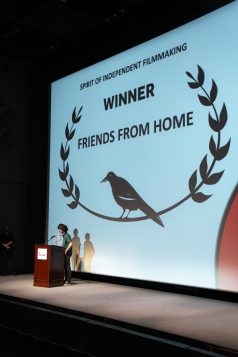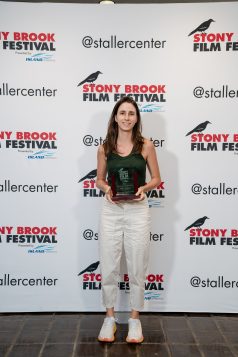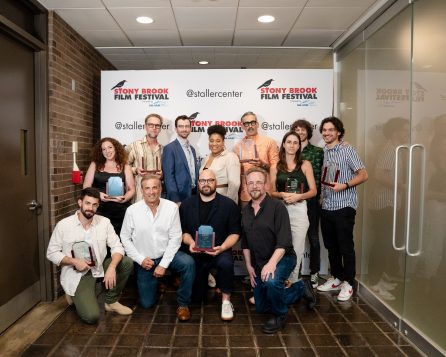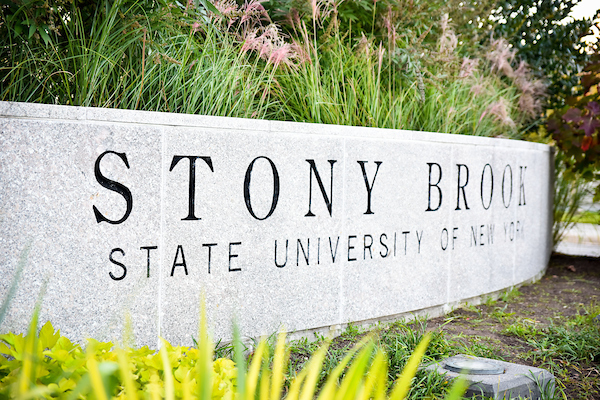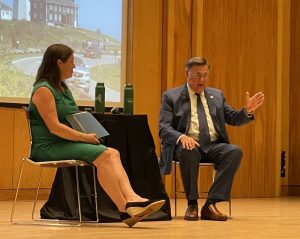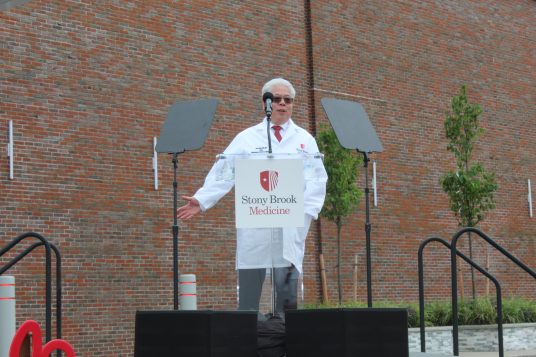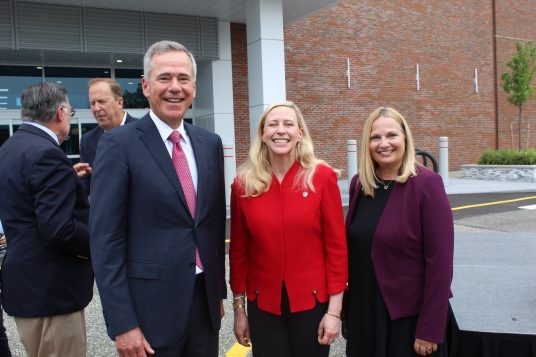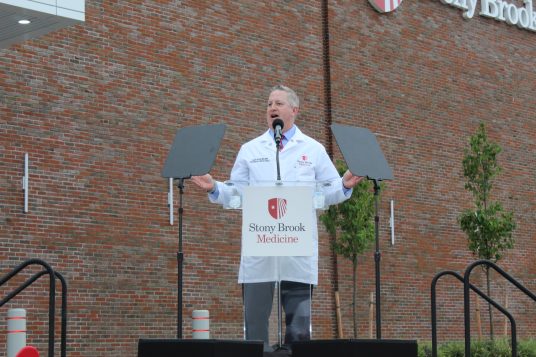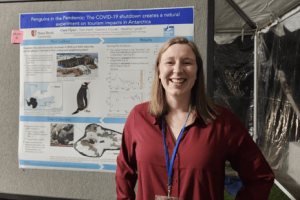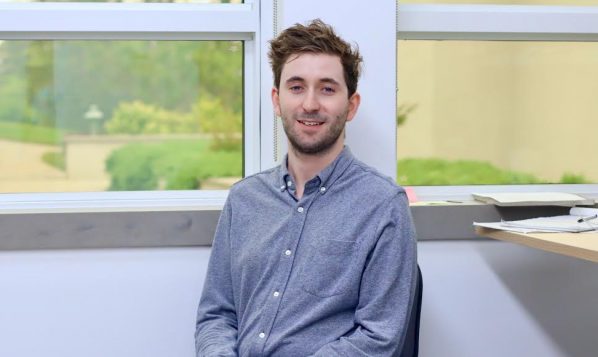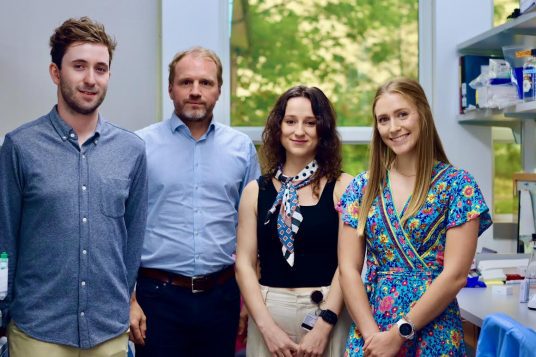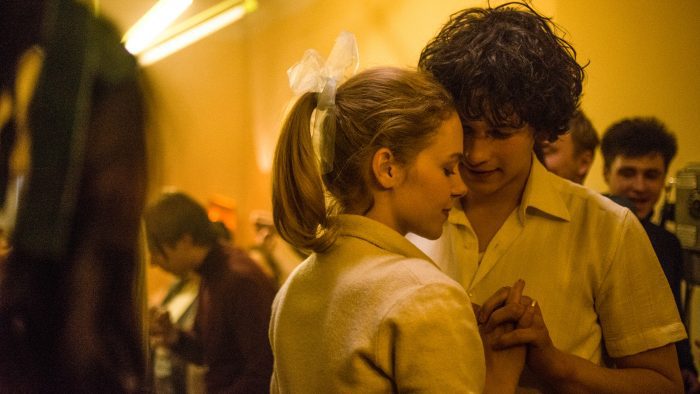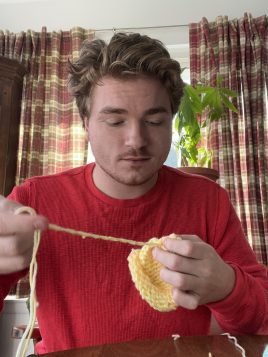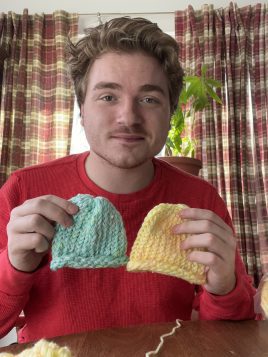The 28th annual Stony Brook Film Festival, presented by Island Federal Credit Union, wrapped up with a Closing Night Awards Ceremony on July 29. The evening recognized the outstanding new independent films screened at the festival, which was held at Staller Center for the Arts at Stony Brook University from July 20 to 29.
With hundreds of artists creating 36 films from 26 countries, the Stony Brook Film Festival became a hub for some of the best filmmakers working today, a meeting ground for favorite actors and rising stars, and a showcase of new masterpieces. Of those 36 films, 11 received awards.
Yes Repeat No, a challenging and engaging meta masterpiece, won the Jury Award for Best Feature. Director Michael Moshe Dahan was in attendance for both the screening and to receive his award. “Thank you to all of the people who believe in human rights and democracy all over the world … and to all the people who want to make difficult material all over the world because finding the questions to ask is sometimes harder than getting the answers,” Dahan said in his acceptance speech.
Two feature films won the audience’s hearts, resulting in two winners for this year’s Audience Choice Award for Best Feature: The Grandson, a charged thriller that boasts “revenge is a dish best served old,” and First Snow of Summer, a masterfully shot and magical romance in a whimsical setting, came out on top.
The Grandson‘s director Kristóf Deák could not be at the Festival to accept his award but remarked, “I couldn’t be happier that The Grandson won the audience award at this year’s Stony Brook Film Festival. I feel a special connection to U.S. audiences since my short film Sing won the Academy Award in 2017. That film’s festival journey also began with audience awards, and for a filmmaker like me who makes his films for audiences, first and foremost, it remains the most important praise.”
“Because it may lead to discussions about how we treat the elderly in our society, I hope [The Grandson]is a testament to how we should never ‘write them off’ as useless. I want to thank my wonderful cast, crew, co-writer, and wife for making this film with me,” said Deák
First Snow of Summer, in its North American premiere, was another beautiful and poignant film from German Sales Team, Picture Tree International. Festival Founder and Director Alan Inkles has been working with Founder/Co-Managing Director of Picture Tree, Andreas Rothbauer, for several years and this is the second consecutive year one of their films has won the Audience Choice Award, with last year’s biting dark comedy, Contra, taking home the same prize.
“You can feel the warmth and genuineness of this new German film, and the audience in our full house screening of First Snow of Summer obviously agreed … the film has a ‘fantasy-like Amelie’ feel to it, and is ripe for a U.S. theatrical run,” said Inkles after the awards ceremony. “One of our goals with the Festival is to get these independent films in front of distributors to help reach larger audiences throughout America,” he added, and said he plans to continue working with Andreas to make that happen.
The Spirit of Independent Filmmaking is awarded to filmmakers that utilize a uniquely indie lens to bring their incredible stories to life. A first in the Festival’s history, this category was awarded to two different features: Friends From Home, a quietly hilarious cross-country odyssey by New York filmmakers, and Where the Road Leads, a Serbian film about a sleepy village brought to life with subtle humor and masterfully directed.
“If you told us we would be watching our film on a 40-foot-screen, we wouldn’t have believed you, and this was awesome,” said Mike Koslov of Friends From Home. “We just tried to make a film as honest and close to the heart as we could,” said Joe Blank, co-writer and director of the film. Both flew in from LA for their screening and the awards ceremony.
Director Nina Ognjanovic traveled from Serbia to be here in person for her screening of Where the Road Leads and for the awards ceremony. Ognjanovic praised the film festival at the ceremony for showing her film to over 400 attendees and for recognizing her work.
The Jury Award for Best Short went to Chipper, while the Audience Award for Best Short went to Stuck.
Director and lead actor of Chipper, Shaun MacLean, and Jayson Warner Smith, respectively, were both in attendance at the awards ceremony, with Shaun attending earlier during the Festival for his screening and leading a lively Q&A. Shoval Chiprut and Daniel Brushin from Stuck flew in from Israel and were present for both their screening and the awards ceremony.
Opening Night Feature Award went to Sea of Time; Closing Night Feature Award went to Divertimento; Open Night Short Award went to The Red Suitcase and The Basics of Love received an for Closing Night Short.
In addition to Island Federal’s generous support as presenting sponsor, additional sponsors for the Stony Brook Film Festival included Campolo, Middleton & McCormick, LLP; Suffolk County; Altice Media; and WLIW/PBS.
2023 FESTIVAL WINNERS
YES REPEAT NO
2023 JURY AWARD FOR BEST FEATURE
THE GRANDSON
2023 AUDIENCE AWARD FOR BEST FEATURE
FIRST SNOW OF SUMMER
2023 AUDIENCE AWARD FOR BEST FEATURE
WHERE THE ROAD LEADS
2023 SPIRIT OF INDEPENDENT FILMMAKING
FRIENDS FROM HOME
2023 SPIRIT OF INDEPENDENT FILMMAKING
CHIPPER
2023 JURY AWARD FOR BEST SHORT
STUCK
2023 AUDIENCE AWARD FOR BEST SHORT
SEA OF TIME
2023 OPENING NIGHT FEATURE
DIVERTIMENTO
2023 CLOSING NIGHT FEATURE
THE RED SUITCASE
2023 OPENING NIGHT SHORT
THE BASICS OF LOVE
2023 CLOSING NIGHT SHORT
———————————————–
During the Festival, the Staller Center announced its exciting Fall 2023 Live Performing Arts season which kicks off on Sept. 5 with Corinne Bailey Rae, Pat Metheny on Sept. 23, Tara McNeill and Alexander Bernstein on Sept. 30, Disney Pixar Coco Live-to-Film concert on Oct. 9, Emerson String Quartet’s farewell concert on Oct. 14, Ballet Hispanico on Oct. 21, Jessica Vosk on Oct. 28, Evan + Zane on Nov. 3, iLuminated on Nov. 5, Tom Segura on Nov. 11, LeAnn Rimes on Nov. 18, Cat Kid Comic Club Musical on Nov. 19, Starry Nights chamber music concert on Nov. 29, Isaac Mizrahi on Dec. 1, Jane Monheit on Dec. 9, and concludes with GALA 2024 on March 9 with special guest Leslie Odom, Jr. For tickets and more information, visit www.stallercenter.com.

